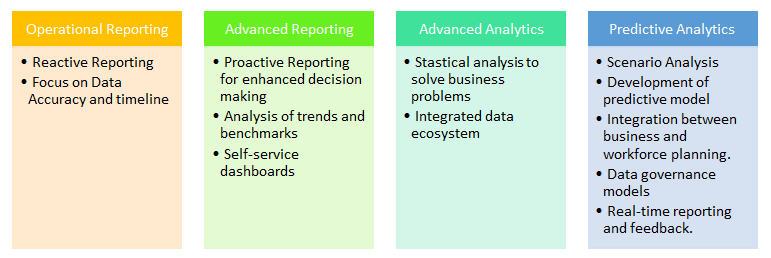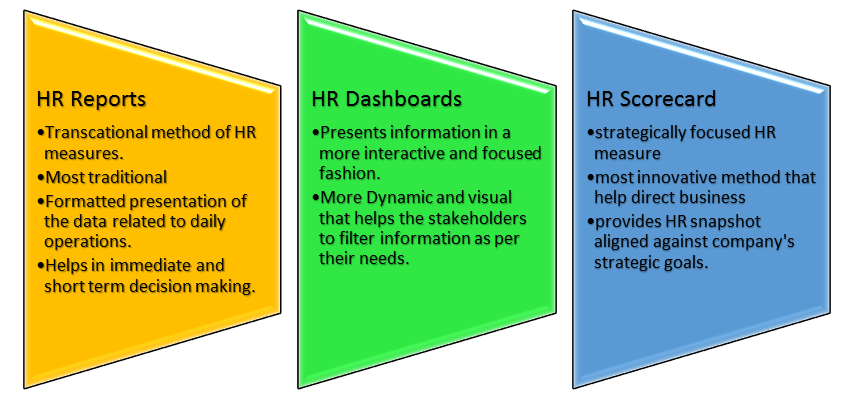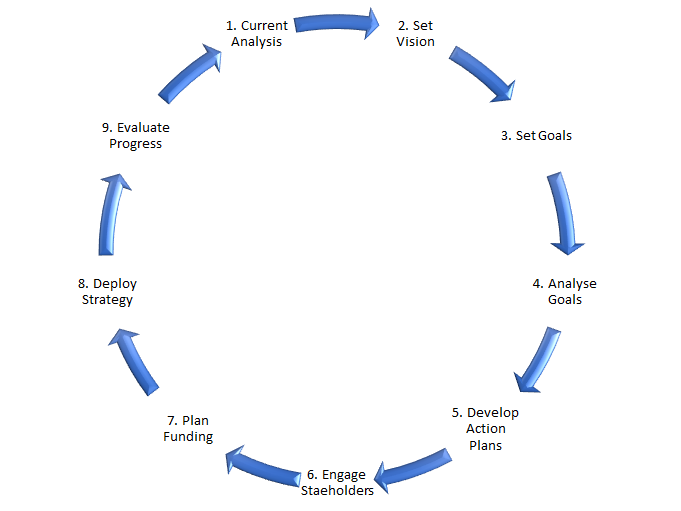The following questions are fundamental for planning and implementing any strategic HR plans:
- Where are We?
- Where Do we Want to Be?
- How are we going to Do That?
- How do we measure our Progress?
Where are We?
There is a paradigm shift in the world of work that even the terms used to describe how to measure performance at the workplace have undergone a transformational change. HR metrics have become a vital component in this service driven economy wherein HR fundamental hurdle has been its inability to quantify its impact.
As we know, numbers are the universal language of every business. Time to fill and cost per hire were not feeding in right proportion as organizations has lowered their risk tolerance abilities and demand for more strategic data has risen. HR metrics is a bang on approach that enhances credibility and rebrand the HR function as more high Impact Strategic function rather than transactional.
This is the goal that we aim at, but the reality is far different. “Most people use data the way drunks use the lamppost: for support rather than illumination”, says Alexis Fink, Intel’s Portland. Hr metrics are operational measures that help us in understanding “what could happen” rather than just “what is happening”. As HR moves from transactional to high impact strategic function, the data approach should also be changed.
Right now, we focus on “bottoms up” approach that extracts operational data from the existing data available in the system which creates a huge gap between the HR measures available and the business need but now the organizations are focussing on “top down” approach wherein they focus on the organizational objectives/business needs then create the measures that will support them.
Need for new HR Metrics
1. Massive data availability and inefficiency to analyse it properly: Organizations these days are flooded with the data, what they lack is right-sizing and appropriate usage to cater to the business needs. As per a survey, only 15% of the organizations gave themselves high marks on data accuracy. Without accurate data, even operational reporting will also not exist.
2. Enhancement of HR technological capabilities: Organizations these days are enabling technologies to enhance the overall customer experience and to achieve the goals of the organization. Adoption of these technologies will result in identifying a clear return on the investments on the new solutions.
“According to a recent Bersin by Deloitte study, 57% of surveyed organization stated that an inability to generate analytics with their old system was a top reason that they were seeking new HR technology”.
3. Demand of HR Analytics: enhanced HR metrics have allowed companies to analyse data within their HR function. Organizations are no more hiring HR’s on their “soft-skills” talent, the focus has moved onto the analytical competencies.
Where do we Want to Be?
Organisational databases accommodate a huge number of data points about their employees; demographic data, performance data, job history, compensation, mobility, training, this list goes on. This data can help us in understanding the behaviors of high performing employees that would be good to replicate by matching it to different types of data across the business. In order to replicate the kinds of conditions that facilitate behaviors that produce positive results, HR professionals historically developed a set of indicators which they collectively agreed would make this possible.
For decades these indicators were called HR metrics. The nature of work and the role of HR professionals has been forced to evolve due to the disruptive impact of technology in the workplace. HR metrics have matured via advances in technological capabilities, from a focus on purely operational reporting, towards predictive analytics that enable HR and leadership to intuit (via large amounts of data and sophisticated algorithms), all the undercurrents running through the workplace that need attention.
HR Evolution Model

How are we going to do that?
Factors to consider while deploying any HR Metrics
1. One should be able to demonstrate the importance of the metricity should be linked to a business outcome. The below questions should be answered to illustrate how the metric is important:
- Do we have skilled workforce for current/future workload?
- Do we have the right people at right place?
- Are we at any risk of losing High Potential employees?
- Do we’ve engaged employees?
- Are we losing too many people?
- Are we focusing on aligning the manpower with the business goals?
2. Simple yet effective- The metric should be easy to understand and deploy at the levels. This should include:
- Calculation
- Data Source
- Master Data-from where the data is extracted
- Who Owns the metric?
- Update Frequency
3. Get a buy-in from all the key stakeholders
4. Promote and communicate the metric in a right way so that everyone gets to understand the importance of it.
5. Take continuous feedback- and implement required changes.
Categories of HR metrics
If you’re measuring the success of any HR transformation or employee satisfaction, one should always consider correct HR metric tool that vertically aligns the business need and is strategically apt. HR metric toll should always consider top down approach whenever analysing any issue. Here are the 3 categories of HR metrics that might help to right-sizing the business needs strategically.

Kinds of metrics
Here is a Balanced Scorecard approach important for organizations these days:
| Financial | ||
| Metric | Importance | Calculation |
| Revenue per Employee | Looks at the value of labour as a revenue generator to an organization. Provides the measure to determine human productivity as a per employee sum of revenue generated. | Revenue $ / Total # of FTE’s |
| HR Expense Factor | Demonstrates a cost of the HR function as a % of the total expense. | HR Expenses / Total Operating Expense |
| Benefit cost as a percentage of total compensation | Provides management with valuable information for use in managing the costs associated with benefits. This information can be useful when looking at hire versus lease or outsource decisions. | Benefit Costs/Total Compensation Costs |
| Cost per Hire | Measures the economic value of the effort taken to fill an open position in an organization. | Internal and External costs associated with sourcing, recruiting and staffing activities / Total # of hires in a specific period |
| Human Capital Cost | Measures the cost of HR for each employee based on FTE Headcount. | Pay & Benefits & Contingent Labour Costs / # of Full Time Equivalent |
| People | ||
| Metric | Importance | Calculation |
| Voluntary Turnover Rate | Determines movement out of an organization (Focus on “who” they are and who they report to). | # employees who terminated during the period / Total # of active employees during the period. |
| Training and Development Hours (or Cost) per Employee | Shows how much we’re investing in people through training and development program. | # of Training Hours (or Cost) per employee for a specific period |
| % of Employees who feel their Leader exhibits expected behaviours | Provides feedback and accountability for how well the Leaders of the organization are demonstrating expected behaviors. | Feedback obtained via tailored survey at set intervals |
| Succession Planning Adherence | Identifying successors for key positions and plan for their development. | Actual plan completed vs. Target plan completed |
| Retention Rate of Employees | Are we retaining our employees (can bucket into groups such as New Hires and High performers ). | # of employees who left during a period / Total # of employees at the end of a period. |
| Customer | ||
| Metric | Importance | Calculation |
| Incidents of Complaints/Grievances | Complaints/Grievances Creates a transparent approach to acknowledge and address complaints/grievances through action. | Total # of grievances |
| Employee Engagement Satisfaction Survey | Survey can be sent out periodically to target groups to gauge an engaged work culture. When executing a satisfaction survey with employees, you must be committed to report the results back to them and be committed to take action in order to address concerns and make required changes. | Score based on design of the survey. Survey can be sent out periodically to targeted groups. |
| Internal Business Process | ||
| Metric | Importance | Calculation. |
| Hiring TAT | A metric of how long it takes an organization to fill a position once the opening has been approved. It is an indicator of hiring efficiency and can provide feedback to determine best sourcing methods. | Total # of Days of Open Jobs/ Total # of Job |
| # of overall days key positions vacant (due to recruiting | A metric of how long it takes to fill key identified positions, looking specifically at recruiting. | Total # of Days of Open Jobs |
| Response time to complete task (in our control). | Provides the ability to track and improve the efficiency of defined tasks within your control. Examples could include response times pertaining to benefits or process transactions. | % of Tasks completed on time. |
| Plan adherence for creation & design of work positions | Ensure that there is a proactive review regarding calibration of current open positions and identification of future positions. | Actual plan completed vs. Target plan completed |
How do we measure our progress?
The short answer will be:
- Performance Measures, to capture results
- Monitoring & Tracking Systems, for evaluation purposes.




